by Heather T. | Aug 10, 2021 | Operations, Reputation Management, Social Media
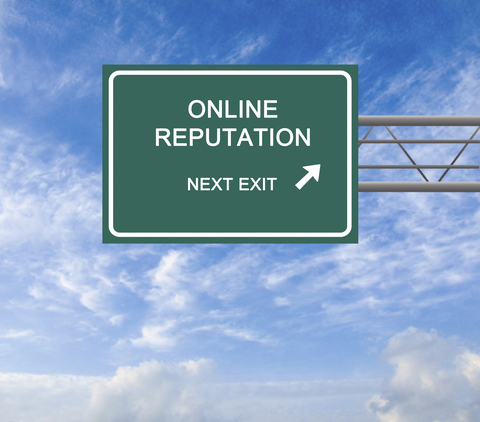 Unfortunately, yes you probably should, but before anyone yells, “invasion of privacy,” I mean the public face of your employee’s social media, so what they post on public forums, Facebook pages, and groups, Twitter, Instagram, etc. You legally can’t ask them for passwords and access to closed accounts, so I wouldn’t recommend it.
Unfortunately, yes you probably should, but before anyone yells, “invasion of privacy,” I mean the public face of your employee’s social media, so what they post on public forums, Facebook pages, and groups, Twitter, Instagram, etc. You legally can’t ask them for passwords and access to closed accounts, so I wouldn’t recommend it.
This periodically comes up when I see employees posting negative content about their employers or, even worse in the case of a boutique hotel many years ago in Maine, posting about guests, by name!
One of my favorite examples is the infamous Damian Cardone, who almost caused the restaurant he worked at to close down because of his public Facebook comments about serving gluten dishes to gluten free guests. And this wasn’t Tavern on the Green, but the restaurant he was working at when he made the posts.
I know it’s one more thing to do on top of trying to do your regular marketing, plus run a business, But…. If any employee’s posts can very negatively impact your business, it’s worth periodically double-checking. Loss of income, especially now, is never a good thing.
Yesterday on a local very active Facebook forum with over 18 thousand members, someone posted a picture of a few people picketing about their workplace’s new mask mandate. Whether you wear a mask or not, or believe we should be vaccinated or not, I’m not going to comment. As someone who last year lost several relatives and friends to Covid, I think you can probably tell where my thoughts lie, and I’ll leave it at that.
On the post, a very vocal young woman was ranting about not getting the vaccine and refusing to wear a mask, and when you hover over her post, you can see where she works.
As someone quite concerned about safety, especially with the Delta variant circulating, this was quite disturbing. She presently works at a local convience store (with the town listed on her profile), and even worse, is a housekeeper/cleaner at a large lodging facility (business name listed on profile). I certainly know I won’t be visiting that local convience store anytime soon nor booking a room at the facility which is in a neighboring state. Which, according to their website has both a mask mandate and an employee vaccination mandate.
I think other people may have commented/messaged both her, and possibly her workplaces about this already because she had removed the information about employment from her Facebook profile as of this morning. I did not report this, but was seriously thinking about it which is why I looked, but someone or someone(s) apparently already did. And I think they posted on the Facebook Business lodging pages reviews tab as well, which was public yesterday, because the review tab is now hidden.
So how many people have those businesses potentially lost or people who have now a negative opinion of the business? Even one is a potential lost customer and loss of revenue and future revenue. From this reference point, on this forum of 18K people, this thread already has 199 comments and who knows how many hundreds or perhaps a thousand or more people have read the post AND the comments and perhaps also saw who this person who ranted worked for…. Food for thought….
If your business falls on that side of the fence where you don’t care if you dissuade people from using your business (for whatever reason), that’s your prerogative and nothing I say or anyone else says will change your mind, so be it. But if you care about your business’s reputation, you should be keeping an eye out.
Sadly, Covid, masking and vaccinations are not the only reason, and the only time, you should be monitoring your employee’s public-facing posts. I have documented hundreds of instances where employees are publicly badmouthing employers, managers, and the businesses that they work at. Great examples for reputation management workshops and I do try to be cognizant of not sharing names of people or businesses unless they are permently closed, like Union Street Guest House, not a case of an employee misstepping online, but instead the owner’s misstepping, but a perfect example of what can backfire online and come back to haunt a business.
This boils down to essential reputation management of your business, where you should be monitoring what people are saying about your business, whether its customers, guests, clients OR employees.
I’d recommend you check your state for what is allowable and what is not in terms of social media and access, as well as specifics on what you are allowed to view on your own company’s computers in regards to employee’s social media. I’d also recommend checking what is considered just cause for termination or fines for employee’s posts.
Posting about bad working conditions or harassment at work falls into personal postings that can’t, and in most cases shouldn’t, be a fireable or finable offense. If an employee is tweeting about being harassed at work, as an employer, you need to look into this pronto, not punish the employee. I’d recommend reading Can You Get Fired if Your Boss Doesn’t Like What You Post on Social Media? from Jackson Spenser Law Group.
NOLO also has a good overview by state, but I would check on your state government-specific website for specifics and the most up-to-date laws as they do change when asking about permissible information to ask and have access to in regards to employee personal accounts.
As a business owner, setting up Google Alerts (free) for your personal name and your business name is suggested. Putting the information in quotes will give you better results.
Periodically doing a Google and Bing search for your personal name and your business name is also suggested (again putting in quotes gives you more specific results), Google Alerts and even the other paid monitoring tools don’t catch 100%.
In terms of employees, before hiring, take a gander at their social accounts (the public side) before hiring. Over 70% of employers do look at that information before hiring, and I have many clients that will ask me to take a look at possible employees who are applying and see what I can find. Considering I’ve found public posts about drinking on the job, stealing products from a current workplace and a lot more that for an emploer would raise some big red flags. It’s scary what’s out there and what people will post publicly.
A tip on looking for a potential employee’s or current employee’s public-facing social media accounts, most people use the same handle or username across most platforms.
Know the law before acting on something that an employee posted. And protect yourself by being proactive; your own business reputation can be at risk. And loss of revenue as well.
From an employee’s perspective, consider what you are posting and where, and who can see it, and the potential repercussions. If you don’t care, again just like an employer’s prerogative to post or believe what they want, that is entirely up to you, but if it meant the potential loss of a job, only you can decide whether it’s worth it or not. If it’s harming the business you work for, that IS on you.
by Heather T. | May 18, 2021 | Marketing
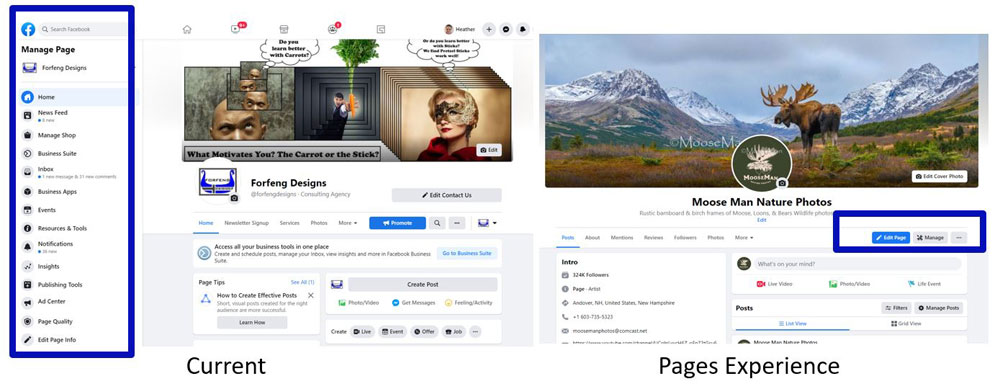
So if you are like most people, you are going “WHAT!!!!!! Facebook Just Changed our Business Pages last year!” Well, folks, Facebook changes business pages looks/formats and options actually about once a year. Sometimes the changes are small, sometimes large, but they do a major revamp approximately every three years and then do some tweaking of settings and looks.
Recently, I had gone through old PowerPoints for workshops I had taught since 2011 and I had screenshots from a decade of Facebook changes. It’s pretty interesting if you have a minute, check it out!
Last year’s change was a major one; this year’s changes are not “quite” as dramatic but do change some things of note.
There have been a few articles written about this, but not many to date, mostly because the switch over seems to be extraordinarily slow for this conversion. Of the 100+ pages, I am an admin on, only two have been switched over so far.
Roaming around on Facebook daily as I normally do for business, I’ve only come across a few other pages so far that have switched. The option to switch does not seem to be connected to the page like count.
You can’t sign up for an early switch, and if you do switch, you apparently have less than a week to decide you want to go back to the old format but no information on how long you can keep that option. Since presumably, we will have to switch over the new format eventually, that one is up to you.
Read a bit more from Facebook about the new version.
About the New Pages Experience (from Facebook) and
Introducing the New Pages Experience (from Facebook)
I do want to mention some of the significant things to note if and when you switch.
- When the option is available, an email will go out to all of the admins and anyone else holding a page role that the new option is being enabled within 3 days. You (and anyone else with any access) will also get a notification in Facebook about it. Please also see notes a few bullet points down re: admins.
- The admin controls are moving to the top (again) right under the banner image instead of on the left.
- Instead of the page administration options of Admin, Editor, Moderator, Advertiser, Analyst, and Custom, this new version only has two admin options. The two being; People with Facebook Access, and People with Task Access. Admin access has full control over everything. Task Access has almost all controls, but it’s more limited. For more specific information, visit https://www.facebook.com/business/help/582754542592549?id=418112142508425.
- Important! Please note that of the pages I admin that have moved to the new format and from several other people I have talked to with the new format. Anyone with access below Admin level with the new page switch will become a full Admin. So your former editors, moderators, advertisers etc. will have FULL access to the page. Please address that immediately, as this also means they can boot you off the page and delete your page as well.
- Page likes go away, but page followers stay.
- Your banner “appears” to be the same size as it was prior, but your profile image moves to the middle of the page and looks like it’s slightly larger than the prior version.
- The new page is basically a “public” profile and has a lot of extra options, not quite sure why a page would want to have: hobbies, sports, TV shows etc., but hey someone I “guess” will find a use for them. The worst part of this, though is there is already some confusion between personal pages and business pages, which was bad enough before, but now this makes it worse.
- A note on the prior bullet point. Currently (for most pages), we have the options of switching page templates, plus we can also hide some tabs (most notably “reviews”). The new option takes away templates. You can hide some of the new options (book etc.), but it does take away the ability to hide the reviews tab and “so far” if you had any external integrations for tabs like an email signup through Constant Contact or Mailchimp or external app application like Woobox (which can bring other social media channels into pages as tabs with other capabilities) no longer. Those options are apparently AWOL in the new version.
- Insights also has some major changes going on. The detail you get now when you check insights is being significantly slimmed down. Facebook does this when this option isn’t used much by users. While there are plenty of people that look at Insights (Facebook’s page analytics), the vast majority don’t. I know this for a fact because 1 out of every 15 people I talk to per month on average about FB business pages has ever actually looked at the Insights. Facebook giveth and Facebook taketh away. I would suggest if you have any interest in tracking past posts, videos, photos, etc. in-depth, you download the variety of data available, and do a last download before switching over to the new format. You can only download the data in 3-month increments, which makes it kind of a pain, but well worth it to be able to have that information if needed.
- I’d also recommend downloading/backing up your page information. While there have (so far) been no reports of data loss or loss of other content. It doesn’t hurt to have a copy anyway….. We had written a post about this prior. Steps to Backing Up Your Personal and Business Facebook Pages.
- Some information from your “About” section does not migrate, so with the page switch you may want to review any information that you had previously, including hiding some of the tabs you might not find applicable or appropriate.
- With current pages, you go to the left and find “Pages” in the list. In the new version, You will switch between your personal profile and your page or pages on the top right, but they don’t call the new version pages anymore, it’s now profiles. (Just to confuse people even more).
- On a smart phone, when you log in to the regular Facebook app it seems to automatically bring you to the page (or in my case) one of the pages I admin, instead of my personal profile so you need to switch back to use your personal account. This may be unique to the iPhone app as I talked to one other person with an iPhone that was running into the same thing and a client with an android phone who had the switch done didn’t think it was happening to him but he is rarely on Facebook.
- This, I think currently is the most annoying thing about the switch. In order to run an ad or schedule a post, you need to switch back to your personal profile to do so. You will also administrate some things through Facebook Business Suite.
I do want to add one more thing of note that Facebook has done without apparently telling anyone. Your formerly private personal accounts (ie, personal profiles), that it used to be someone had to be logged into Facebook to see anything from your account, like your banner photo and personal photo are now public to the world, i.e. people not logged into Facebook at all.
From a business standpoint, this may be a plus; on the other hand, it does expose not just yourself but also any friends who have commented on a personal banner, it allows access (view) to their accounts and makes their comments public to the world. Clicking on the Likes/Loves does not bring someone (not logged in) to a user’s account, but a comment does.
You may also want to see what else is visible now to the whole wide world. Capture your URL, so https://www.facebook.com/yourusername and either open up an incognito window in Chrome, log out of Facebook and put the URL in, or open a browser you don’t use for Facebook and put the URL in. One of the reasons this blog post is titled Jeepers Creepers is because Facebook continues to let the world see your life, whether you want them to or not. Please do note though, there is a fairly new option on your personal profile to add a short line of text plus a website URL, this is public on your personal profile while not logged in. So take advantage of this if you own a business.
I suspect more changes are coming, and I’ll add another post as any new developments that are important for a small business to stay up on are rolled out.
by Heather T. | Apr 21, 2021 | Marketing, Operations

On the second two photos you can see a watermark, see one on the first one? No? But it “might” have a digital watermark.
As anyone who has sat in on one of my workshops or seminars and heard me stress the importance of making sure any photos you use on your website are legal, this will be preaching to the choir. If not, I want to revisit this for anyone who has not heard me rant about the importance of checking provenance.
What IS the provenance of images? Making sure you know where they came from legally.
In the last few years, I’ve lost count of the number of people who have run into copyright-related issues because they, OR their website developers, have run into an issue with copyright and photo/image usage.
If a client provides a photo to a web developer for use on the client’s website, the client is clearly at fault and needs to work with the photographer and/or agency to resolve the copyright claim.
Unfortunately, some web developers also provide stock photos (provenance unknown) for clients’ websites. The client gets hit with a copyright suit, and the web developer does not take responsibility for it, even though they were the ones who supplied the image.
A few more things to note, this can also happen when a web developer (legitimately) buys stock photos for a website. Then a client transfers the site away from the web developer to someone else and doesn’t obtain the licensing information for the photo.
Or the photo is obtained from a “free” stock photo site, and the site is not 100% safe (I’d say most of the free stock photo sites are questionable) because who knows if the photographer claiming ownership is the owner) and you also can’t see what’s called a Digimarc watermark or other types of invisible-to-the-eye watermark systems. Many copyrighted photos have tracked back to Getty Images from free stock photo sites, so I tend not to trust any of them.
I’m particularly anal-retentive about photo copyright because many, many years ago, when I was still doing website design, I obtained a photo that I thought was free and clear from what at the time was a legitimate free stock photo site and used it on a client’s website.
My client received a cease and desist letter from Getty Images, and even though we removed the photo immediately and provided documentation about where the photo was obtained, they still sent collections after her. And the collections agency was calling the inn literally every hour during the day to harass her.
I paid the fee to get it cleared up, because it was my fault for providing the image. Since then, I’ve lost count of the hundreds of people coming my way and looking for advice having run into similar problems. Either they used a copyrighted photo unknowingly or their web developer provided a photo or in a couple of cases, multiple photos and they got nabbed for it.
Very recently, a related issue came up, and this topic reared its ugly head again, so I thought it would be a good time to revisit this.
A website that myself, one of my clients and about a dozen other commercial photographers had a written agreement with an association that in order to use our photos, there were to be photo credits with links back to our websites on the website itself and this was done prior.
The website recently got redone with the new web developer not transferring any photo credits for any of the photos.
I won’t detail the issues and communication that arose from this, but my photos and my client’s photos (which was my primary concern) were removed from the new site as this issue did not get resolved to our satisfaction.
Unfortunately, dozens of other photos remain that need to be credited to the other commercial photographers. If my client had caught this before I had, he would never have reached out and tried to get this resolved; he would have just sent them a cease and desist letter/copyright infringement notice plus tacking on usage fees.
I know some of the other photographers that contributed photos, and I suspect they would and may do the same. I did my due diligence and let both the site owners and web developers know about this, which has not yet been addressed looking at the site this morning.
What bothers me most about the recent issue is that one, the web developer not only failed to transfer the photo credits in the first place. If they were on the old site (which they were) that it should be common sense/a good legal move, to move them as well.
Two, the web developer did not even bother to check the provenance of the photos.
Three, and this is a little detail from above, when asked to give photo credit, added photo credits to photos that were not the photographers, leaving the photographers open to liability for copyright infringement themselves.
For businesses, the takeaways should be:
- Know where you got your site photos. Are they documented? Are they legal? If you have photos on your site that you have had for years, and you are not sure where they came from, it doesn’t mean your safe; it just means you might not have gotten caught yet. Sometimes it can take years for a copyright issue to come up.
- If a web developer provides photos, where is the provenance for them, and will they take responsibility (they should!) if a site they developed for you gets hit with a copyright infringement claim for an image or images they provided? If they refuse to when asked about this issue (and I’d get this in writing), you need to use your judgment about whether that’s someone you want to use as a vendor.
- If you switch web developers, keep in mind you need to either get provenance of any stock photos that the prior site developer has provided for you or replace them with new ones that you know are legal.
- if you buy stock photos from a stock photo site make sure you take a screenshot of the site with the page that photo is getting purchased from including the licensing information. Document, document, document. Sometimes photographers remove their photos from stock photo sites and then do image searches or unscrupulous firms do searches for them (unknown to the photographers). If you have proof it was bought legally, your in the clear.
- If you do source photos from free stock photo sites, include the URL of the page the photo came from and screenshot and date the screen of the page it came from. This won’t protect you from one of the big stock photo companies but may help if a private photographer claims copyright.
Here are a few sites where you can do a reverse image search on your images.
https://tineye.com/
https://www.labnol.org/reverse/
https://smallseotools.com/reverse-image-search/
by Heather T. | Dec 23, 2020 | Marketing, Social Media
A common question I get from friends and clients is what happens if my business page or personal account gets deleted or I get locked out or banned from Facebook? Well in some cases it can be recovered, but in some, it can’t. Most of the concern understandably is about photos that might have been uploaded to a page or profile from a mobile phone and in many instances the copy on Facebook is the only copy.
From a business perspective, it’s not just photo loss, but what if you want to find a copy of a post from last year? Or two years ago? You can sit there for an hour plus and scroll back through all the posts in your insights, but having done that myself several times looking for past post information, set aside an extra hour (or two) to be able to find something, It’s ALOT of scrolling. Being able to download (and sort easily) that information can be very helpful.
Let’s start with the Facebook personal page, Facebook changed how you get to this option fairly recently for both profiles and pages. The last time I reviewed this was back about 3 years ago and there are some definite changes plus it’s always a good reminder.
Step one for a personal profile: Go to the top right of your Facebook account and click on the small downward-facing pyramid to “Settings & Privacy”
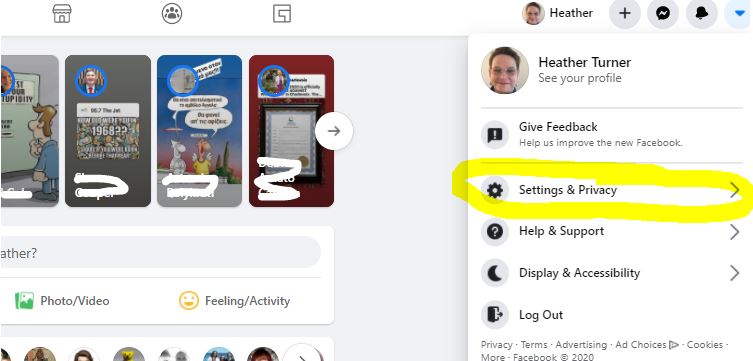
Step 2: Go to “Settings”
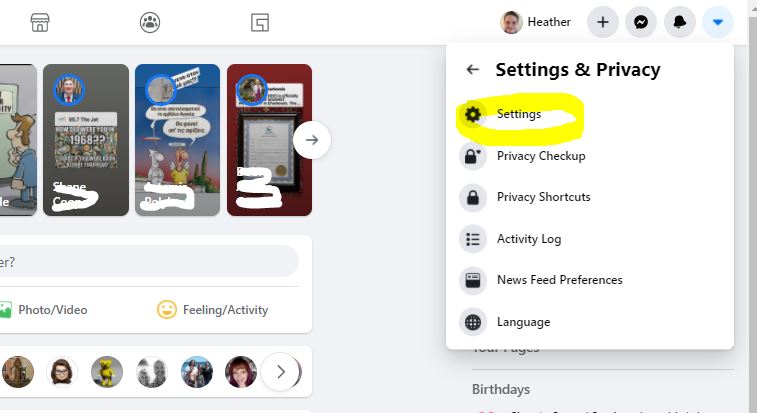
Step 3:**** Go to “Your Facebook Information” and than “Download Your Information”
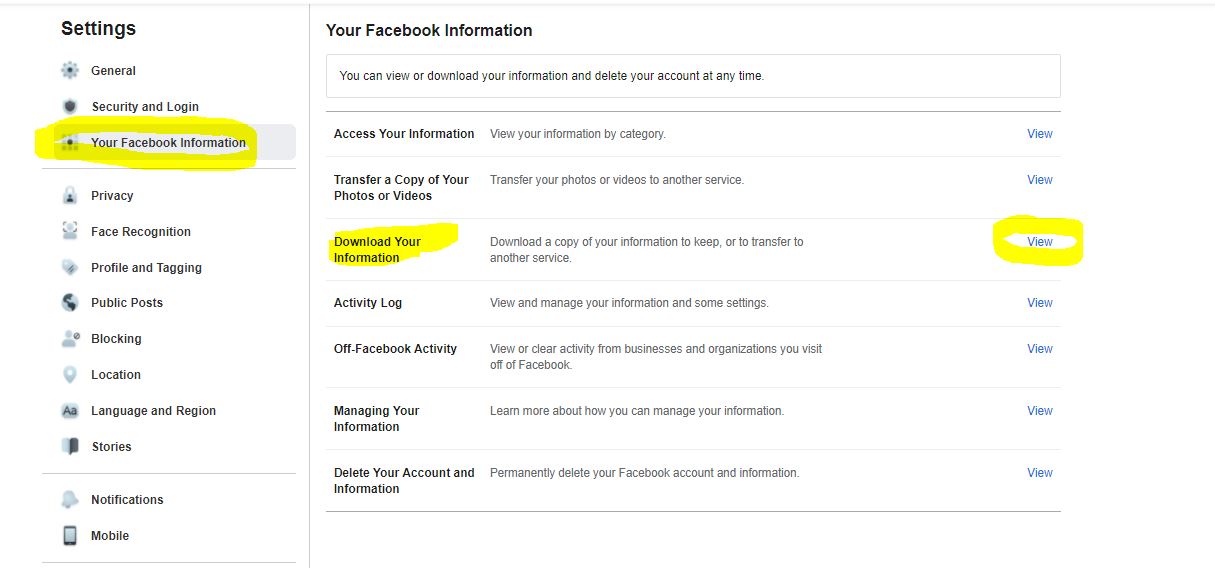
****Facebook frequently changes the options (and many of the settings) in the backend of accounts without letting anyone know, I highly recommend Facebook users go and review what the options are in here at least once quarterly if not more often.
Step 4: if you have everything selected, be warned, it’s going to take a long time to process. So deselect all and than do the ones you have an interest in backing up.
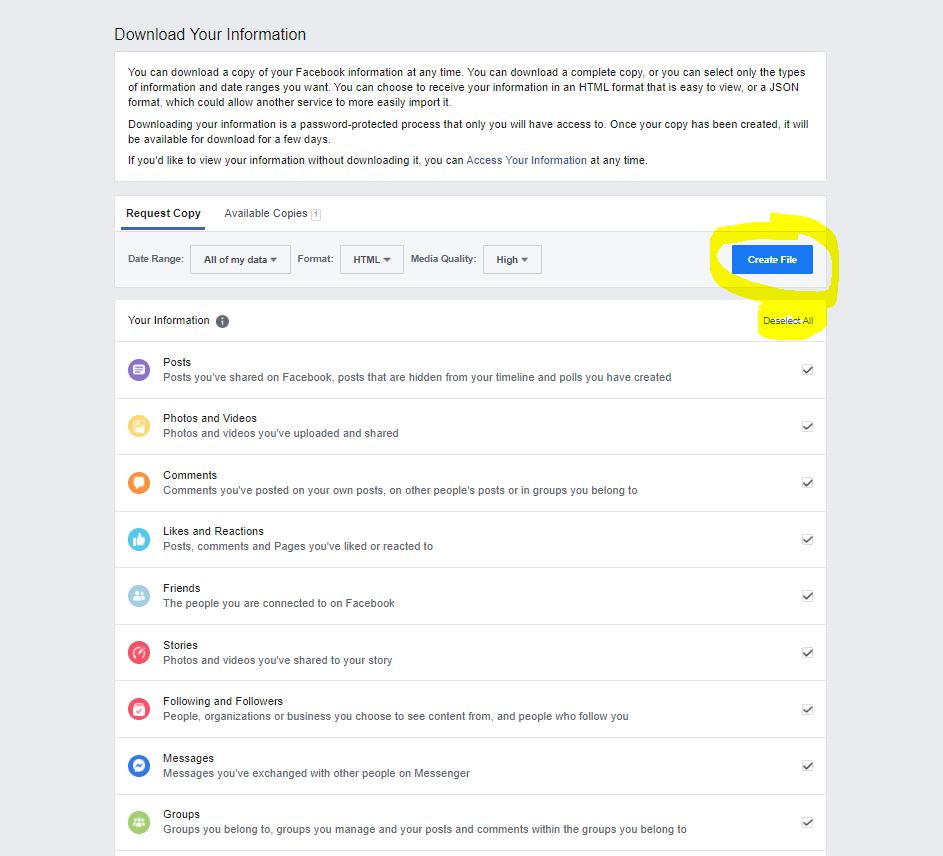
You will get two emails from Facebook, the first saying it’s processing, the second will come when your Zip file is ready to be downloaded. You will also get a red notification on the page above when it’s ready. If you get the second email saying it’s ready and you still had the above page open and it says “pending” refresh the page on your browser.
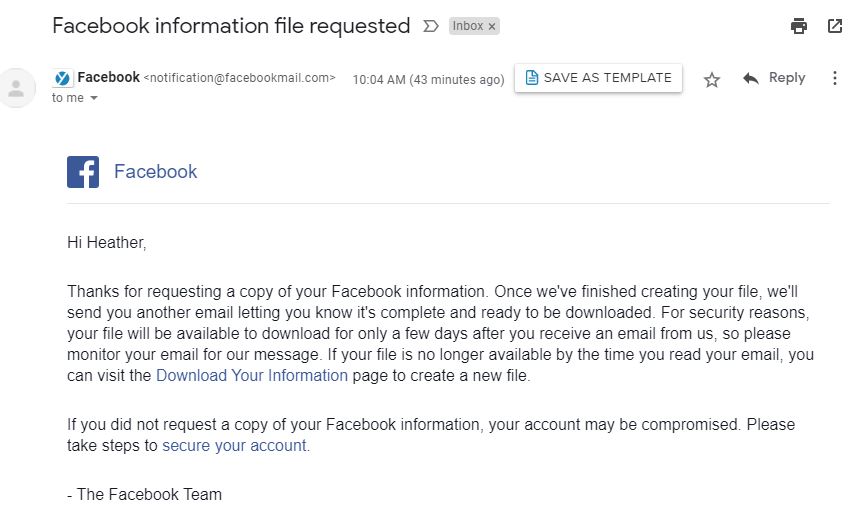
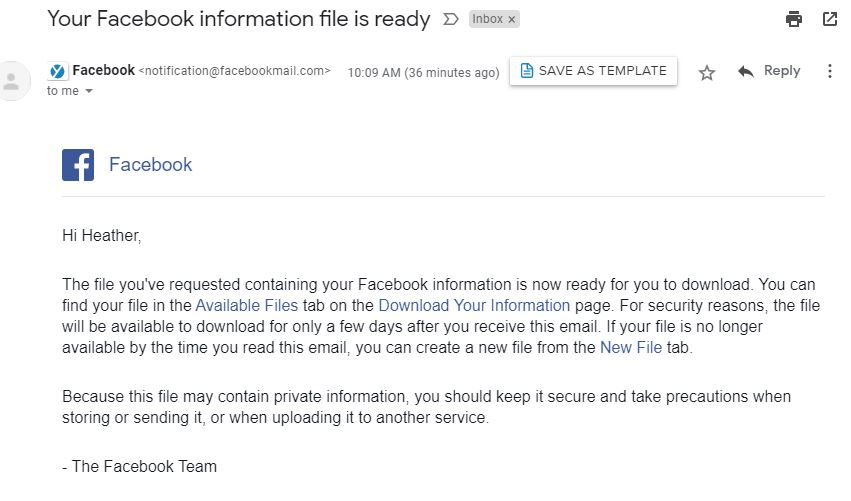
For a business page:
Step 1: On the left hand side of your Business page when you are on as an admin, go to “Settings”
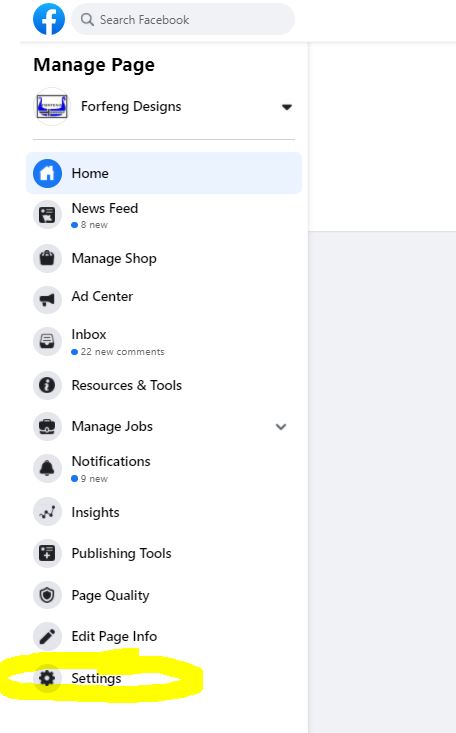
Step 2: On the General tab, go to the middle of the page to “Download Page” and than “edit”. When you click on that there will be another option to hit “Download Page”.
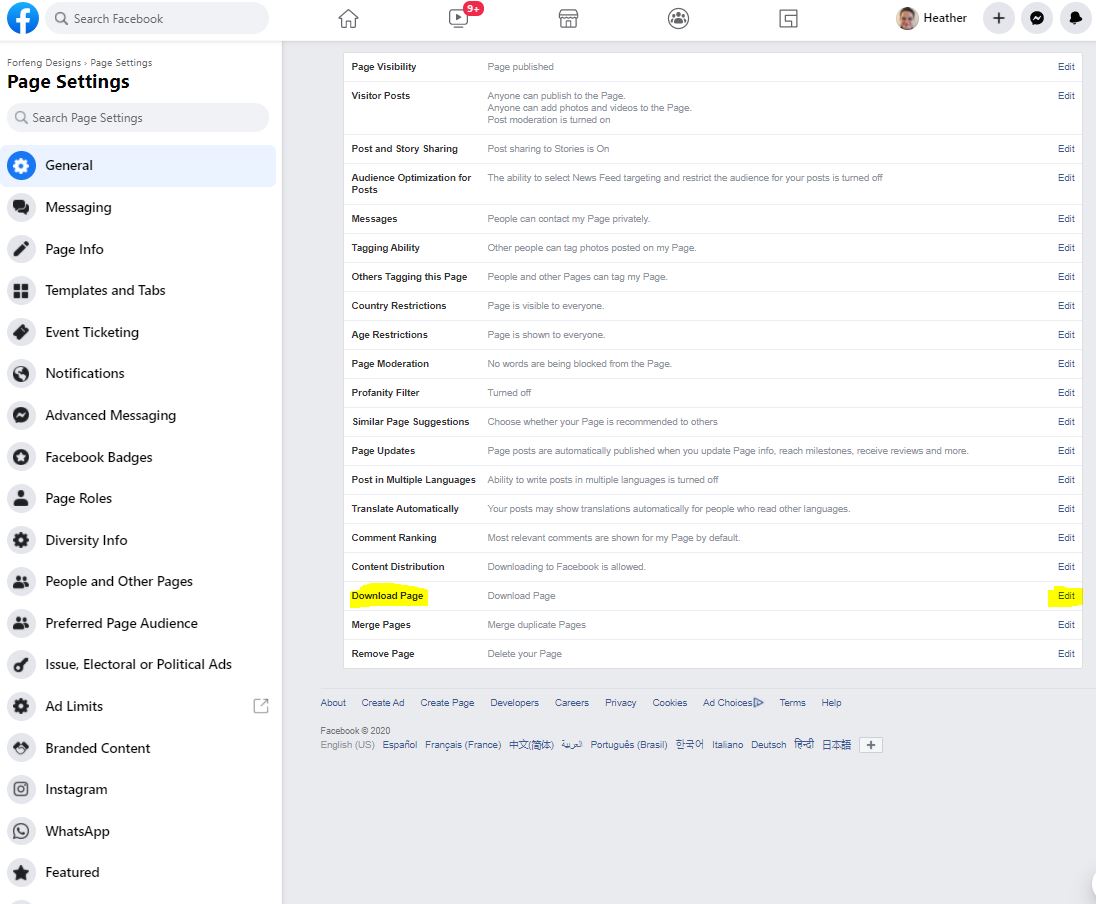

Step 3: You will get a very similar looking page to the personal profile options, but it will say “Download Page” at the top to make sure it’s being differentiated from your personal account.
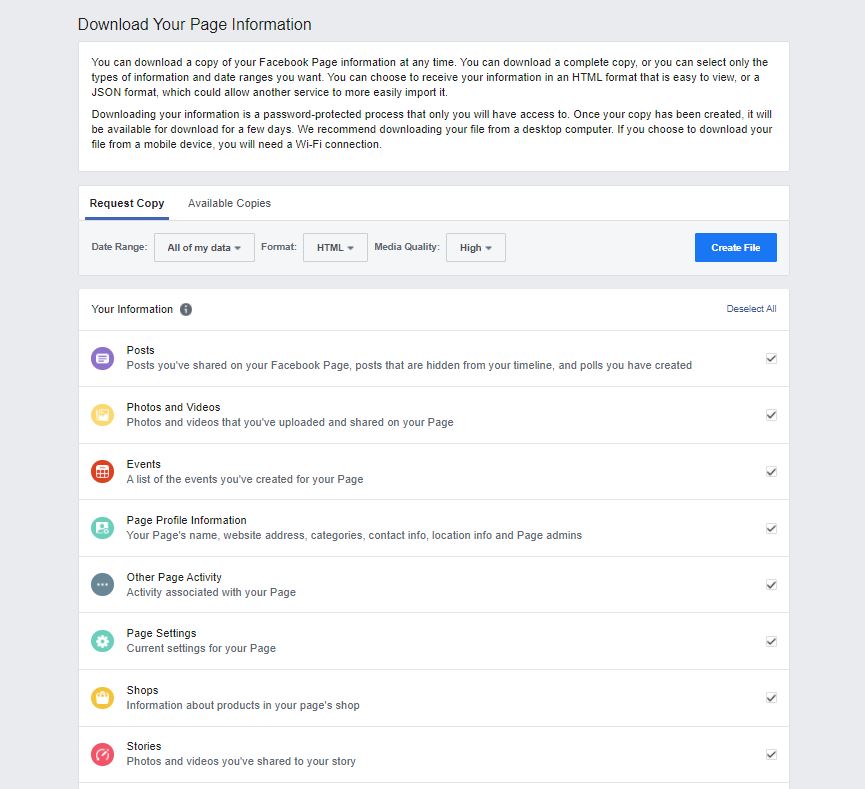
I’d recommend doing this at least once per year for both personal and business at the very minimum, I do this quarterly for any accounts I admin as the last thing you want to have is information that is not recoverable in any way.
I can’t stress enough the importance of backing up not just your social media information but all of the information on your computer on a consistent basis. I’ve talked to so many businesses who say they know they should be doing it and don’t and very much regret it when their computers fail, they have a break-in and their equipment gets stolen or there is a disaster like a fire or flood. If you are on of those people who know you should be doing it, but don’t, I would ask you to ask yourself, “Can my business function and how long will it take (and can I, and my business) recover, if my information is lost, maybe irretrievably forever.
by Heather T. | Dec 14, 2020 | Food, Recipes
So I teach social media for a living, why on earth am I posting recipes? Well, I DO still do restaurant consulting and my background is cooking. and while in the past I have always had a clearly defined line between Cook and Baker, that line has blurred over the last 6 months as I find I do like to bake (formerly not so much) as long as I can play with amounts and ingredients, that’s a long story in itself.
So why post some recipes? Well, a lot of people besides myself are still doing a lot of quarantine baking, it is something not depressing (especially if it regards anything chocolate) which I think we all need a little of that around now, the non-depressing AND the chocolate, and from a marketing perspective, recipes are one of the most shared things on the internet. That’s about as much of a half baked ? reason I think you will get.
I have recently discovered that cookies are easy to put together and bake, and I can imagine some virtual eye rolls going on about now, but I had mentioned I did not like to bake prior, right? I seem to recall baking Christmas cookies as a kid, but that beside Baking and Pastry classes for a few weeks at CIA as part of the Culinary Program was the extent of my cookie making experience.
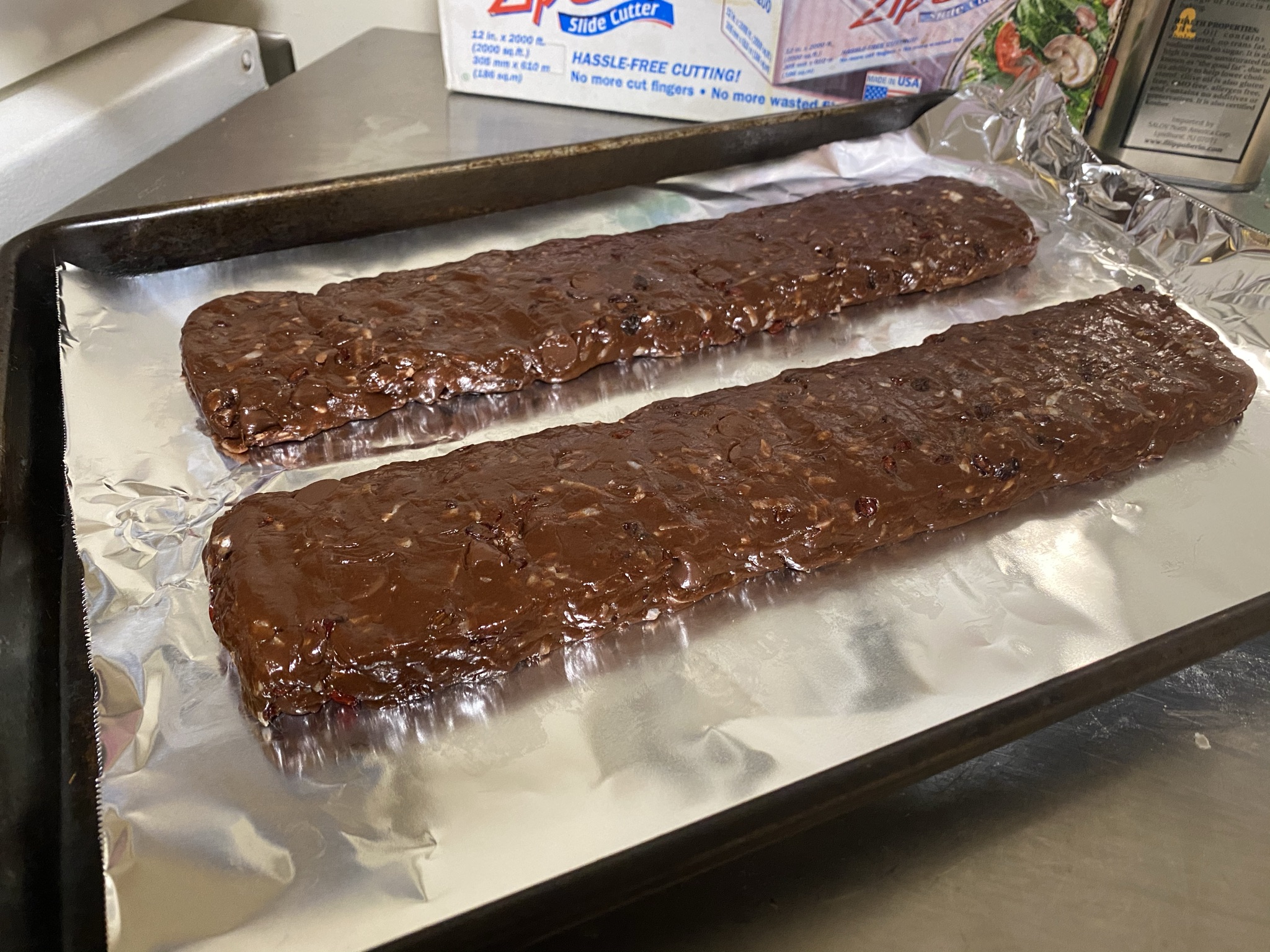 So in the course of working my way through various cookie recipes I decided to try making some biscotti, I mean what the heck, it’s a cookie, how hard can this be? So in my browsing for interesting biscotti recipes, I came across, Cranberry Pistachio Biscotti from Allrecipes. I am not a huge fan of cranberries but figured I could sub out dried cherries or dried blueberries in it.
So in the course of working my way through various cookie recipes I decided to try making some biscotti, I mean what the heck, it’s a cookie, how hard can this be? So in my browsing for interesting biscotti recipes, I came across, Cranberry Pistachio Biscotti from Allrecipes. I am not a huge fan of cranberries but figured I could sub out dried cherries or dried blueberries in it.
This weekend I decided to try my hand at it. I did not have any of the extracts left and didn’t have pistachios, so a little recipe editing was in order, plus I’ve recently developed an unhealthy (actually very healthy) addiction to cocao (not cocoa) powder and barberries (Zereshk) and have been putting both in a lot of my baked goods. The end result was actually extraordinarily good and I definitely will be making them again. A good litmus test for my baking is my husband picking up a piece and walking into my office and saying, “what’s this?” Munch, Munch. “Their good!”
Ingredients:
- ¼ cup pure olive oil
- 2 large eggs
- 4 tea maple syrup (I added a touch more liquid than the extracts original recipe to balance out the addition of the cocao powder)
- ¾ cup sugar
- 1 ¾ all purpose flour
- 1 tea kosher salt
- 1 tea baking powder
- ½ cup organic cocao (not cocoa) powder, not an affiliate link I just happen to like this brand
- ¾ cup barberries (I think pretty much any other dried fruit could be used)
- 1 cup milk chocolate chips, white or dark chocolate could be substituted
- 1 cup sweetened shredded coconut
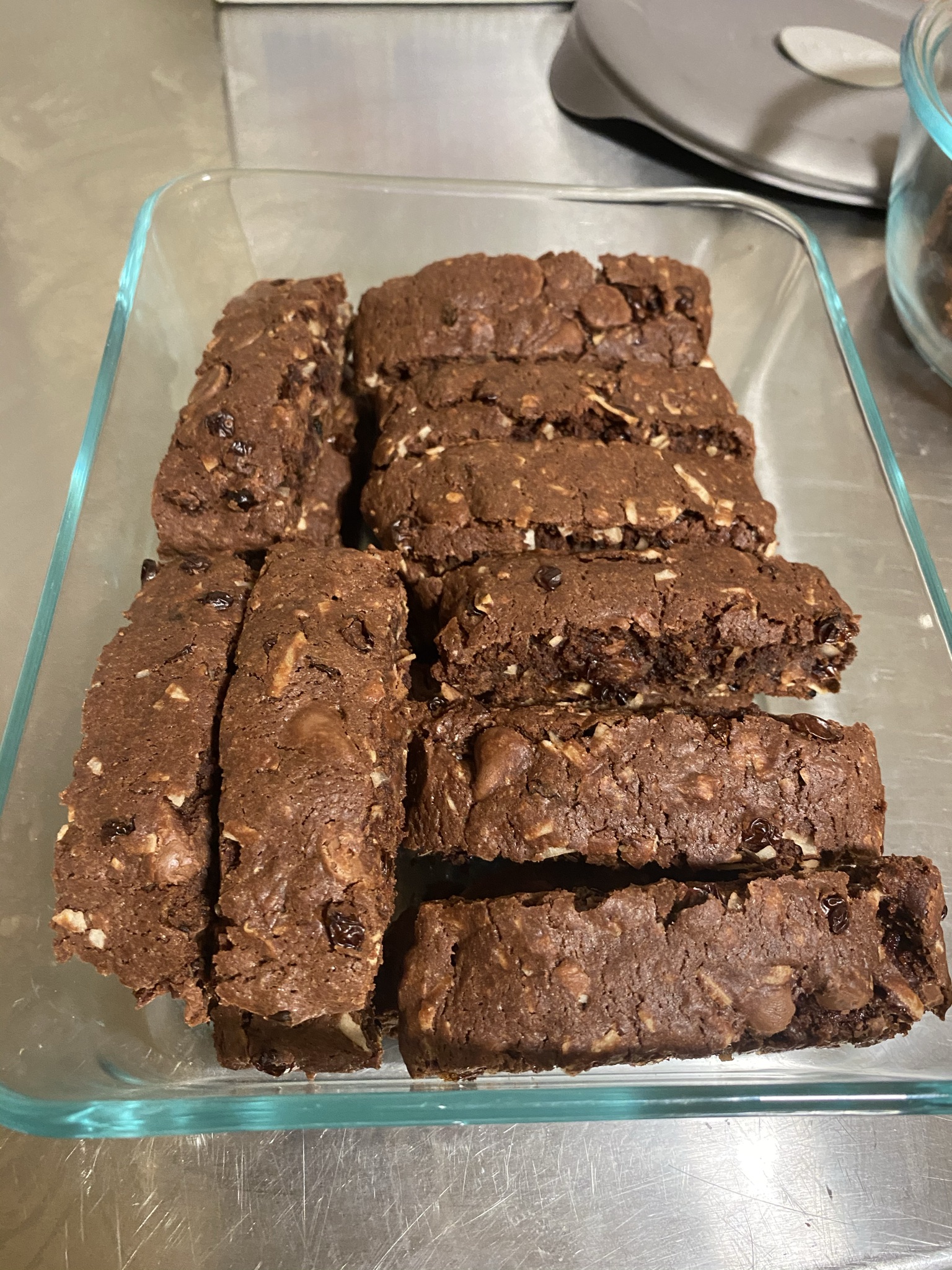 So my process for this was a bit different from Allrecipes and technically I think the ingredients have changed so much it’s not even the same or similar recipe, but I do still want to try the original, sans cranberries and wanted to credit the original source of the idea. You can use less salt if you prefer but I find most of these recipes online never actually have the amount of salt needed to make the product taste like it should. 1 tea of kosher salt for all of those ingredients is a drop in the bucket. I know everyone is sodium conscious, but I find 99% of the baking recipes out there online can be massively improved by just a small salt addition to the recipe. And for heavens sake stop using iodized salt. Yuck!
So my process for this was a bit different from Allrecipes and technically I think the ingredients have changed so much it’s not even the same or similar recipe, but I do still want to try the original, sans cranberries and wanted to credit the original source of the idea. You can use less salt if you prefer but I find most of these recipes online never actually have the amount of salt needed to make the product taste like it should. 1 tea of kosher salt for all of those ingredients is a drop in the bucket. I know everyone is sodium conscious, but I find 99% of the baking recipes out there online can be massively improved by just a small salt addition to the recipe. And for heavens sake stop using iodized salt. Yuck!
Method:
- Preheat over to 300
- Whisk together olive oil, eggs and maple syrup
- Sift together the flour, sugar, salt, baking powder and cocao powder
- Slowly incorporate the egg mixture into the flour mixture, I used both hands for this, you may want to wear gloves as it’s a bit sticky. When all of the flour mix is well incorporated, add in the chocolate chips, dried fruit (barberries in this case) and shredded coconut.
- Split mixture into two pieces and place on a baking sheet, Allrecipes called for parchment paper, I happened to be out, so tinfoil with cooking spray or a silpat mat works as well. Form the mix into to long logs, about an inch and ½ high by 12 or so inches long.
- Bake for 35 minutes. I cooled for about 5 minutes (not 10) and cut the logs into 1+ inch slices. I separated the slices out a little bit and then re-baked.
- Reduce oven to 275
- Bake for another 10 minutes, I think you can bake these for a few more minutes and they would be fine, but I like the crisp but not overly dried out results these had.
Happy Baking!
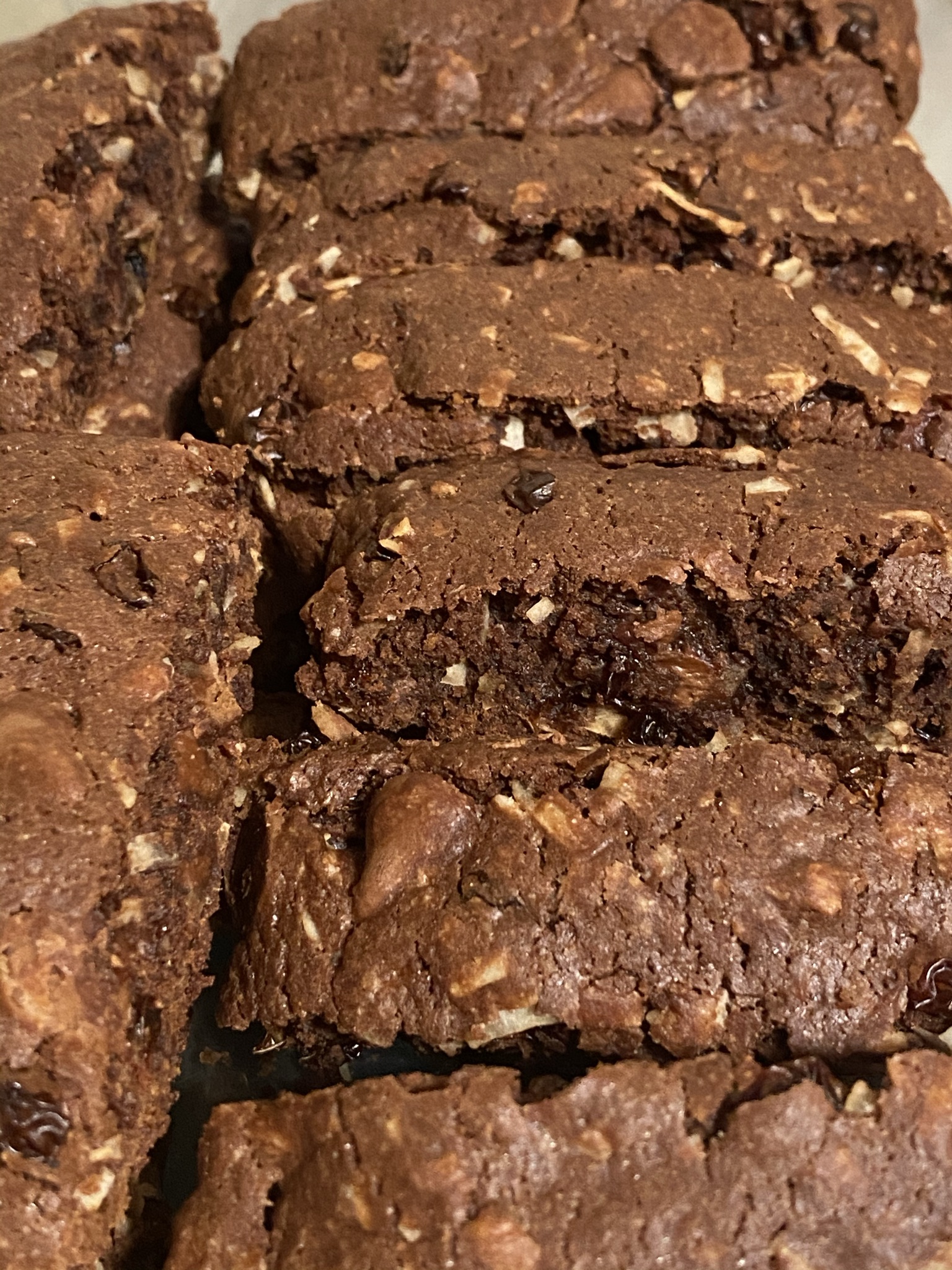
If you liked the recipe, we always appreciate a follow/like on our Facebook page (we don’t post a ton there as I personally prefer being able to chat with people but I am on FB pretty much all day during the week and your welcome to message me anytime) but would appreciate a page like and happy to reciprocate if you let us know your business page link, or you can connect on Linkedin or Twitter or just come say hello. Questions or comments about the recipe as well always happy to help with.
If you know someone that can use some social media help and would like to be able to learn it and manage it themselves (that’s what we do, we teach it) instead of paying an external company to manage it, please give me a call (860-326-0721) or email me, we are happy to help. Cheers and Happy Holidays. Please stay safe out there!
by Heather T. | Dec 9, 2020 | Bed and Breakfasts, Blog, Marketing, Operations, Social Media
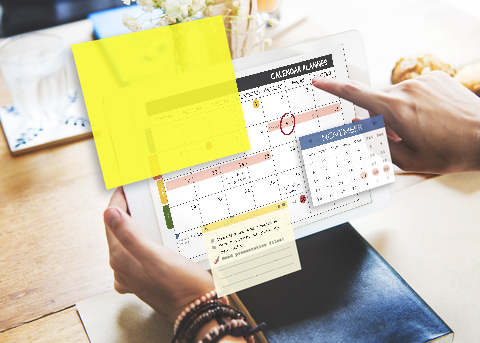 About 4 years ago I had written a blog post about Planning Ahead for Your Bed and Breakfast Promotions and this ties into the new calendar I’ve put together (below) and your content scheduling, or you can adapt or just use one format or another. Here is the online spreadsheet from that post (don’t forget you can download it and it does have multiple tabs). Tips on downloading or copying if needed near the bottom of the post.
About 4 years ago I had written a blog post about Planning Ahead for Your Bed and Breakfast Promotions and this ties into the new calendar I’ve put together (below) and your content scheduling, or you can adapt or just use one format or another. Here is the online spreadsheet from that post (don’t forget you can download it and it does have multiple tabs). Tips on downloading or copying if needed near the bottom of the post.
At the beginning of this year with Covid hitting and B&Bs being closed or having a limited business, the big question was what to post, so I had designed this campaign with posting ideas https://betterwaytostay.com/campaign/. And the idea can still be used at any time.
I’ve had several questions from friends and other B&Bs if I was going to do the annual National and other Days of interest list that I do once a year compiled from a bunch of sources around the web. Since I had just finished next year’s calendar I am happy to share, but I also added some other tips (in the additional documents in the post) that might make posting and figuring out when to post for specials and other events (like Holidays) a bit clearer and hopefully easier.
It’s much easier to take about an hour at the beginning of the year, if not before, and develop at least a rough outline for your content calendar for the year and add to it (or subtract) as needed. Here are some content calendar ideas that I hope will help you start to develop a content calendar. The National Days is just a starter and I know every marketer under the sun pushes it, but it is admittedly a great “starting” point. I spent about 4 hours collating National, International Days and other Days of interest including as many food ones as I could find. This might be useful for restaurants as well looking for a few ideas to post. If you know of any I missed please let me know and I’ll add them in.
National and More Days for B&Bs (with some specific days as prompts)
National and More Days for B&Bs (no selections/prompts)
Calendar Example for a B&B. This is an example of a property going through the list and leaving the ones they might be interested in using for potential posts or blog or video posts. It doesn’t mean a property will do them, it just means a property found something interesting in the list, something that speaks to them (military family), a love of fun (Soylent Green Day or UFO Day for those with a sense of humor and love of Sci-fi), particular food days that resonate with things the B&B serves for breakfast, etc. Note this list is 11 pages pared down from 17.
Calendar Example for B&Bs with Specials. This is an example of preplanning your yearly calendar for posts and promotions that can be used stand-alone or in conjunction with the spreadsheet mentioned at the beginning of the blog. I only did the first couple of months but hopefully, you can get a good idea of how to go about adding information both for notes for yourself and scheduling posts for any ongoing specials or holidays you want to promote.
This is a PDF fillable calendar. (please download to fill) that you can fill in and print off or just print off and write in ideas (note please save it as a separate document or it may not save any inputted text). I would suggest making a checkmark next to the ones you’ve done, plus making any notes about engagement, likes, shares, and comments, these will help direct you in the following years if you want to do similar posts or promotions.
Content Calendar Sample Format. If you prefer a calendar type format instead of a spreadsheet or word document for figuring out your posting schedule you can use a format like this. There is no wrong way to do this, you find the format that works the best (and easiest) for you and go from there.
Blank Calendar-Sample Tracking. (I like to track likes, comments and shares on a seperate sheet, but you can also handwrite if that works for you (see below example). It helps if you note what you started with for each channel and ended with for each channel. Facebook January 1-352 Likes, January 31-386 Likes, etc. this will help you track progress and you can review quarterly to see whether what you are doing is actually working or not.
Content Calendar with Handwritten Notes *note circles mean a link to the inn’s website main or sub-page or blog post on the website.
Something some B&Bs don’t do is link to their website or a specific page on their website in posts at least once a week. If you are wondering about conversions and clicks from social media (and why you are not getting many or any) it’s something you need to look at.
I was talking to an innkeeper earlier this week and she was complaining that while her posts on Facebook were getting a lot of engagement, she had not gotten a single click through from Facebook in more than 3 months according to her Google Analytics. Not one of her over 100 posts had a link to the website in the post body itself. People tend to forget once someone has liked a page, the only link (unless you remind them in the posts that show up in their Facebook personal feed) to your website is back “on” the business page itself. People will not double click to search for the link.
This is How to make a copy or download a document (for reference if you want to use anything mentioned here offline or copied digitally)
I’d also recommend checking out You Need This 2021 Marketing Calendar [Free Templates] and his spreadsheet of helpful links and dates which does have things like the NHL Winter Classic, PGA Tournament of Champions, and the Grammy’s dates if these are things that you want to tie into your marketing but does not have the majority of the food dates that mine does. My calendar has most of the same information plus food but is missing sports and TV related events.
If you find any of the information above useful, we always appreciate a follow/like on our Facebook page (we don’t post a ton there as I personally prefer being able to chat with people but I am on FB pretty much all day during the week and your welcome to message me anytime) but would appreciate a page like and happy to reciprocate if you let us know your business page link, or you can connect on Linkedin or Twitter or just come say hello .
If you know someone that can use some social media help and would like to be able to learn it and manage it themselves (that’s what we do, we teach it) instead of paying an external company to manage it, please give me a call (860-326-0721) or email me, we are happy to help. Cheers and Happy Holidays. Please stay safe out there!
by Heather T. | Nov 25, 2020 | Blog, Food, Recipes
 This recipe is a long treasured one, developed by master pastry chef Linde Beale at a restaurant in Kingston, NY that I worked at as one of my very first jobs in the restaurant business.
This recipe is a long treasured one, developed by master pastry chef Linde Beale at a restaurant in Kingston, NY that I worked at as one of my very first jobs in the restaurant business.
Ingredients:
1 1/2 cups good quality chocolate chips, dark chocolate is preferred but milk works as well
3 1/2 cups all purpose flour
1 1/2 tea. Double acting baking powder
3/4 lb. (1 1/2 cup) butter
1 tea. pure vanilla
1/2 tea. Mace
1 lb, plus one cup light brown sugar (3 1/4 cups firmly packed)
5 eggs
3/4 cup milk
1/4 cup bourbon
Method:
Grease and flour a Bundt pan. This recipe can also be baked in loaf pans
Sift the flour with the baking powder and set aside
With an electric mixer (paddle), cream the butter, vanilla and mace
On low speed, slowly add in the sugar and increase the speed slightly.
Incorporate the eggs one at a time into the butter sugar mix
Add in the milk and bourbon
Sift in the flour mix (this is a double sift, sifting prior and than sifting in again)
Mix until incorporated
Add in the chocolate chips and briefly mix just until incorporated.
Add batter to the pan and bake for an hour and 25 minutes at 350 or until a toothpick inserted comes out clean.
Let the baked cake sit for about 10 minutes and then remove onto a sheet pan. The glaze for this needs to be added while the cake is still warm.
Glaze
1/3 cup granulated sugar and 1/4 cup bourbon
Dissolve sugar over low heat, brush over warm cake until mix is completely gone. Let cool.
This cake can be stored for several days unrefrigerated. If you refrigerate it the consistency of it changes drastically and becomes much firmer and the bourbon flavor more pronounced. (preferred). It also freezes very well.
I love this cake served with some bourbon and honey flavored whipped cream. Snacked on at Midnight is also a favorite 🙂
 Unfortunately, yes you probably should, but before anyone yells, “invasion of privacy,” I mean the public face of your employee’s social media, so what they post on public forums, Facebook pages, and groups, Twitter, Instagram, etc. You legally can’t ask them for passwords and access to closed accounts, so I wouldn’t recommend it.
Unfortunately, yes you probably should, but before anyone yells, “invasion of privacy,” I mean the public face of your employee’s social media, so what they post on public forums, Facebook pages, and groups, Twitter, Instagram, etc. You legally can’t ask them for passwords and access to closed accounts, so I wouldn’t recommend it.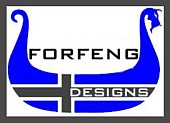












 So in the course of working my way through various cookie recipes I decided to try making some biscotti, I mean what the heck, it’s a cookie, how hard can this be? So in my browsing for interesting biscotti recipes, I came across,
So in the course of working my way through various cookie recipes I decided to try making some biscotti, I mean what the heck, it’s a cookie, how hard can this be? So in my browsing for interesting biscotti recipes, I came across,  So my process for this was a bit different from Allrecipes and technically I think the ingredients have changed so much it’s not even the same or similar recipe, but I do still want to try the original, sans cranberries and wanted to credit the original source of the idea. You can use less salt if you prefer but I find most of these recipes online never actually have the amount of salt needed to make the product taste like it should. 1 tea of kosher salt for all of those ingredients is a drop in the bucket. I know everyone is sodium conscious, but I find 99% of the baking recipes out there online can be massively improved by just a small salt addition to the recipe. And for heavens sake stop using iodized salt. Yuck!
So my process for this was a bit different from Allrecipes and technically I think the ingredients have changed so much it’s not even the same or similar recipe, but I do still want to try the original, sans cranberries and wanted to credit the original source of the idea. You can use less salt if you prefer but I find most of these recipes online never actually have the amount of salt needed to make the product taste like it should. 1 tea of kosher salt for all of those ingredients is a drop in the bucket. I know everyone is sodium conscious, but I find 99% of the baking recipes out there online can be massively improved by just a small salt addition to the recipe. And for heavens sake stop using iodized salt. Yuck! 

 This recipe is a long treasured one, developed by master pastry chef Linde Beale at a restaurant in Kingston, NY that I worked at as one of my very first jobs in the restaurant business.
This recipe is a long treasured one, developed by master pastry chef Linde Beale at a restaurant in Kingston, NY that I worked at as one of my very first jobs in the restaurant business.
